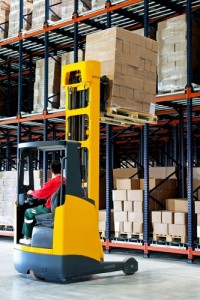Technology Takes the High Road in Warehouses
Technology has improved the way warehouses and delivery trucks deliver.
Recently I met with some clients who were in the market for a warehouse space. Normally, when discussing a space, the client’s greatest concerns include the square footage, IT connectivity, and usable space—but in the world of warehousing, technology has reset the paradigm, and vertical space has become even more prized than the two-dimensional area of usable space.
The driving force behind this sea change is superior engineering and technology, which allows warehouses to adopt sophisticated order fulfillment systems.
My clients were approaching their search for a space with this in mind. They knew, for example, that the need for a large horizontal footprint could be mitigated substantially if the storage space was able to accommodate rows of goods that were four pallets high instead of just three.
Note: A typical North American pallet has a footprint of four feet by four feet, and a height ranging from four to five feet, depending on the goods being stored.
In the real world, that means a tenant occupying a 50,000-square-foot warehouse, stacking three pallets on top of one another, can increase its storing capability by 33% if they add one more layer of pallets.
Various hardware innovations serve to make the vertical shift more than a pie in the sky. A new generation of forklifts makes it possible to narrow aisles by splaying their forks and achieving a smaller turning radius. Two examples of this technology can be found in the records storage facility used by New York City’s Health and Hospitals Corporation and the New York City court system. Taking vertical storage to the extreme, the completely automated facility is able to store records up to six pallets high.
In contrast to medical charts and legal opinions, items like produce or other perishables simply cannot be stored for longer periods of time. To remedy this, software engineers work in concert with architects and industrial engineers to track each item through the use of barcodes or radio frequency tags. Such tools allow complex analysis of the efficiency of an operation, such as analyzing so-called “pick rates”—the time it takes to assemble the product for an order into one box for shipping.
The last piece to the challenge of attaining near-perfect efficiency is the delivery vehicles themselves. Navigation programs are able to determine the quickest routes, ways to avoid highways or toll roads, or even routes that consist entirely of right-hand turns.
Having represented dozens of companies in search of warehouse space, I have witnessed quite an amazing transformation in the way goods are stored and handled. Very often, the investment in technology is recouped by paying for a smaller space. To learn more about warehousing solutions, send me your questions!
George E. Grace
Mohr Partners, Inc.
232 Madison Avenue
New York, NY 10016
646-312-6800


